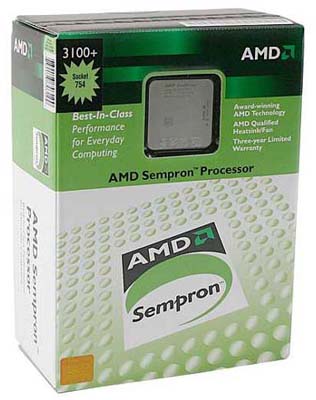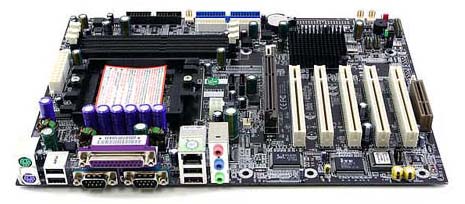Buyer's Guide - Entry Level, October 2004
by Jarred Walton on October 6, 2004 12:05 AM EST- Posted in
- Guides
CPU and Motherboard: Budget Gaming
Very few applications can stress a processor as much as a game, so we recommend that anyone with an interest in the hobby plan to spend more money. Some might even go so far as to say that the words "budget" and "gaming" do not belong in the same sentence, but we feel that budget gaming is possible - you just have to increase funding by a little. If you can cut down on those fast food trips and eat ramen noodles for a month, you should be able to afford a decent gaming system.
Gaming CPU: AMD Sempron 3100+ 256K 1.8 GHz 400 MHz bus
Price: $120 shipped (Retail)
In order to help you get your gaming fix, we have moved from socket A to socket 754 for our CPU and motherboard recommendation, and the Athlon XP has finally been replaced by the Sempron 3100+. For a price increase of roughly 25% over the Athlon XP 2500+, performance is increased by a similar amount. In addition to the increased performance, the newer socket 754 platform should allow for more upgrades in the future as they become necessary.
Socket 754 was previously the domain of the 64-bit Athlon 64. However, in order to cut costs and avoid cannibalizing sales of their premium processors, AMD has reduced the amount of cache to 256K and disabled the 64-bit extensions. These omissions do not affect performance as much as they might on another platform, though, since the integrated memory controller remains and 64-bit application and operating system support continues to be delayed. Right now, it is difficult to find a gaming processor that can match the price of the Sempron 3100+ while still providing sufficient horsepower to run current and upcoming games well.
Should you wish to gain even more CPU performance, you could always opt for an Athlon 64 2800+ or 3000+. Again, the naming conventions may cause some confusion, but remember that the Sempron competes against the Celeron line of Intel and not the Pentium 4. The 3100+ is equivalent in speed to the Athlon 64 2800+ (1.8 GHz) only without the additional cache and without 64-bit support. Our benchmarks of the processor show that, on average, the 2800+ is about 5% to 10% faster, making the additional 20% increase in price a losing proposition for the budget gamer.

Gaming Motherboard: Chaintech VNF-250
Price: $77 shipped
By moving to socket 754, we increase the price of the motherboard slightly as well, but the feature list is also improved. In addition to sound and network, two SATA connections with RAID 0/1 support are included. Those may not be important features for anyone on a tight budget, but it is difficult to complain about their inclusion when the price and performance are so good. The Chaintech VNF-250 also uses the latest NVIDIA Nforce3-250 chipset, which is currently the top choice for socket 754 and 939 motherboards.
You might notice that the same CPU and motherboard recommended here matches our value overclocking configuration. This is simply one more perk that comes along with the package. We will defer to the Overclocking Guide for those seeking more detail on this subject. Even without overclocking, the performance of the Sempron 3100+ and Chaintech VNF-250 remains very good.










53 Comments
View All Comments
kmmatney - Wednesday, October 6, 2004 - link
We are going completely small form factor at my office, using either the ASUS Terminator or, lately, ASUS T2-P with Celeron-D. They've all worked great, and no problems using on-board graphics.The ASUS Terminator + Duron is simply an incredible value. The ASUS T2-R is also nice, with ATI Radeon 9100 graophics.
kherman - Wednesday, October 6, 2004 - link
kherman - Wednesday, October 6, 2004 - link
Left kinda confused. I see alot of areas I simply didn't like. In particular, for a true Office rig, where data intergretty is VERY important, I'd suggest 2 hard drives and a software RAID solution. Same total cost for hard drives, but it's justfied in terms of budget. Spend the same amount. for gaming, go for fast loading. For office, go for redundancy. The Office rig would actually have more alloted to the hard drive, but isn't that the critical component in an office rig?I say this every time I see a write up. You really need to start mentioning it, even if it's simpyl an alternative office solution that costs more. Most people using a PC for home office use, don't have a server running RAID 5 available and it almost seems as though it's an assumption.
Other than this, I loved that article. Also, for home office, I can't see recomending 17" monitors. You need to generally run higher resolution and see more of the screen to be efficient in a home office.
To be honest, I have to say that "a "budget rig" for office shouldn't be much cheaper than he gaming rig. Monitors and redundancy are important factors here where gaming rigs need a killer video card.
Please consider this in the future.
boomerang - Wednesday, October 6, 2004 - link
Very happy with the more in-depth explanations and choices given in the guide. I very much depend on these guides when building systems.You are to be commended for a job well done!
iversonyin - Wednesday, October 6, 2004 - link
since we in the entry level budget, why not get a generic case+ PS. generic case usually got for ~$35i would not run XP with 256 MB RAM even its only for office use. IMO
PrinceGaz - Wednesday, October 6, 2004 - link
On the last page in the Additional Alternatives table, the Power Supply Upgrade has the wrong item name.Iger - Wednesday, October 6, 2004 - link
Thanks for the nice guide, I love explanations too :)About monitors - there actually are Samsung 795 DF ones, which handle 1280x1024@75 for a few more $ :)
Gholam - Wednesday, October 6, 2004 - link
$14, Bayfield is just way too expensive - why not use a D865GVHZ if you're determined to go Intel?Gholam - Wednesday, October 6, 2004 - link
$14, Bayfield is just way too expensive - why not use a D865GVHZ if you're determined to go Intel?Scarceas - Wednesday, October 6, 2004 - link
I've had seen at least one business app that didn't run right on an nForce motherboard. It was wierd.Anyway, I never seem to have any trouble with stability or configuration when using an Intel-branded motherboard with an Intel CPU.
It does cost a bit more, but the in the total cost of ownership equation, the hardware itself is definitely not the largest factor, especially on a budget near this one.
The previously mentioned application is a good case in point: the money saved in hardware was easily ate up in service/support to troubleshoot the program.
I like the Intel D865GBFL motherboard, and if you're going budget, a Celeron D 320 will fit nicely ($165 shipped from Newegg).
In an office environment, the performance delta is not so critical, and I don't mind spending $35 more if it reduces support issues.
Just something to conside...